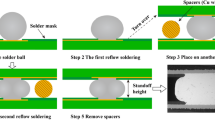Abstract
Microstructures within ultrafine electronic interconnections, which change rapidly during the formation of such joints and evolve continuously thereafter under service conditions, are an important factor to be considered in order to accurately evaluate the reliability of electronic packages that contain such interconnects. By combining phase-field and finite-element mechanical modeling techniques, this work explicitly considers both the size and geometry of the joints to understand their effects on microstructural evolution and subsequent mechanical properties. The simulation results indicate that the degree of inhomogeneity of the stress distribution increases as the size of the joints is reduced when microstructure is considered. The calculated maximum stresses present in hourglass-shaped joints when considering microstructure are approximately 10 MPa larger than those present in the corresponding joints when neglecting microstructure. The geometries of such interconnects also have a significant effect on their mechanical properties. Hourglass-shaped joints exhibit the lowest maximum von Mises stresses in comparison with the other shapes considered. In addition, the included microstructural features can introduce local stress concentrations within the microjoints, which may deteriorate the reliability and performance of the electronic packages. It is therefore recommended that the microstructure as well as the size and geometry of joints be considered among the design and fabrication parameters to enable reliable ultrafine interconnects.
Similar content being viewed by others
References
S.K. Kang, M. Cho, D. Shih, S. Seo, and H. Lee, Proceedings of the 58th Electronic Components and Technology Conference (2008), p. 478.
S. Chen, C. Wang, S. Lin, C. Chiu, and C. Chen, JOM 59, 39 (2007).
Z. Huang, P.P. Conway, E. Jung, R.C. Thomson, C. Liu, T. Loeher, and M. Minkus, J. Electron. Mater. 35, 1761 (2006).
I. Dutta, P. Kumar, and G. Subbarayan, JOM 61, 29 (2009).
S.K. Kang, D. Shih, D. Leonard, D.W. Henderson, T. Gosselin, S. Cho, J. Yu, and W.K. Choi, JOM 56, 34 (2004).
K.S. Kim, S.H. Huh, and K. Suganuma, Mater. Sci. Eng. A 333, 106 (2002).
H. Shin, B. Kim, J. Kim, S. Hwang, A. Budiman, H. Son, K. Byun, N. Tamura, M. Kunz, D. Kim, and Y. Joo, J. Electron. Mater. 41, 712 (2012).
Z. Huang, P.P. Conway, and R.C. Thomson, Microelectron. Reliab. 47, 1997 (2007).
X. Liu and G. Lu, IEEE Trans. Compon. Packag. Technol. 26, 455 (2003).
R. Darveaux, C. Reichman, C.J. Berry, W. Hsu, A. Syed, C. Kim, J. Ri, and T. Kim, Proceedings of the 58th Electronic Components and Technology Conference (2008), p. 113.
B.S.S.C. Rao, D.M. Fernandez, V. Kripesh, and K.Y. Zeng, Proceedings of the 12th Electronic Packaging Technology Conference (2010), p. 423.
Z. Huang, P.P. Conway, H. Davies, A. Dinsdale, Z. Wu, and B. Wang, Proceedings of the 12th International Conference on Electronics Materials and Packaging (2010), p. 60.
R.S. Chen, S.C. Tseng, and C.S. Wan, Int. J. Adv. Manuf. Technol. 27, 677 (2006).
M. Erinc, P.J.G. Schreurs, and M.G.D. Geers, Int. J. Mater. Struct. Integrity 2, 35 (2008).
A. Zamiri, T.R. Bieler, and F. Pourboghrat, J. Electron. Mater. 38, 231 (2009).
S.G. Kim, W.T. Kim, T. Suzuki, and M. Ode, J. Cryst. Growth 261, 135 (2004).
K.K. Hong and J.Y. Huh, J. Electron. Mater. 35, 56 (2006).
M.S. Park and R. Arróyave, Acta Mater. 58, 4900 (2010).
N. Moelans, Acta Mater. 59, 1077 (2011).
H. Xiong, Z. Huang, Z. Wu, and P.P. Conway, Calphad 35, 391 (2011).
MATLAB—the Language of Technical Computing-Getting Started with MATLAB Version 7.8 (The MathWorks Inc., MA, USA, 2009).
COMSOL Multiphysics User’s Guide Version 4.2 (COMSOL AB, Stockholm, Sweden, 2011).
S.G. Kim, W.T. Kim, J.S. Lee, M. Ode, and T. Suzuki, ISIJ Int. 39, 335 (1999).
COMSOL Multiphysics—Structural Mechanics Module User’s Guide Version 4.2 (COMSOL AB, Stockholm, Sweden, 2011), p. 36.
G. Ghosh, J. Mater. Res. 19, 1439 (2004).
R.J. Field, S.R. Low III, and G.K. Lucey, Jr., Physical and Mechnical Properties of Intermeallic Compounds Commonly Found in Solder joints. (National Institute of Standards and Technology, 2011) http://www.metallurgy.nist.gov/mechanical_properties/solder_paper.html. Accessed 8 July 2012.
H. Ma and J.C. Suhling, J. Mater. Sci. 44, 1141 (2009).
Author information
Authors and Affiliations
Corresponding author
Rights and permissions
About this article
Cite this article
Wu, Z., Huang, Z., Xiong, H. et al. Linkages Between Microstructure and Mechanical Properties of Ultrafine Interconnects. J. Electron. Mater. 42, 263–271 (2013). https://doi.org/10.1007/s11664-012-2201-8
Received:
Accepted:
Published:
Issue Date:
DOI: https://doi.org/10.1007/s11664-012-2201-8




